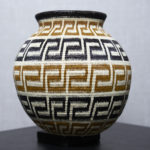What is a ‘Hosig Di’ Basket?

Today, the Wounaan and Embera in the Darien of Panama are best known to the outside world for their fine baskets which are called ‘Hosig Di’, the Wounaan word for the fine art chunga baskets. The Wounaan people are the originators of this fine art. The Hosig Di are a relatively new art form. Early examples date back to the 1980s. However, basket weaving is not new to either the Wounaan or the Embera people. Utilitarian baskets were made much earlier for food and plants gathered in the rain forest.

Chunga, the thread used to sew these baskets, comes from the black palm tree. Chunga is the symbol of force and power. The wood and fiber from these black palm trees are closely linked to Wounaan traditions and daily life.

The baskets are made with tender, young emerging leaves from the top of the black palm trees. The tall trees have long sharp spines on their trunks. The trees are impossible to climb. Since trees are no longer allowed to be felled, nowadays, Wounaan men are using ladders to reach the top of the trees to remove emerging spear leaves. The chunga leaves are then stripped and split into fine thread-like fibers, washed in rain water and bleached in the sun.

Nahuala is used to form the central core of the fine baskets. Nahuala is a cyclanth, a member of the Cyclanthaceae family although it looks like a low-growing fan palm tree.

Chunga fibers form the thread used to sew, (called a silk stich), around the Nahuala core. The colors are natural and are extracted from fruits, leaves, wood shavings, roots, mud, ashes and other natural products found in the tropical rain forest. The intensity of the color varies according to how long the chunga fibers are left in the dye.

Since the Wounaan began making baskets for collectors and tourists they have incorporated plants, birds, fish and other animals into their more traditional geometric designs. The Wounaan certainly make some of the Best Baskets in the World!


